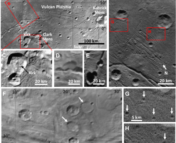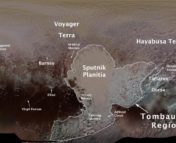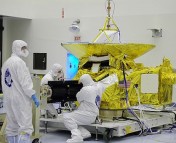Title: Hypotheses for Triton’s Plumes: New Analyses and Future Remote Sensing Tests
Authors: J.D. Hofgartner, S.P.D. Birch, J. Castillo, W.M. Grundy, C.J. Hansen, A.G. Hayes, C.J.A. Howett, T.A. Hurford, E.S. Martin, K.L. Mitchell, T.A. Nordheim, M.J. Poston, L.M. Prockter, L.C. Quick, P. Schenk, R.N. Schindhelm, O.M. Umurhan
First Author’s Institution: Jet Propulsion Laboratory, California Institute of Technology, Pasadena CA, USA
Status: Accepted to Icarus [closed access]
The plumes of Triton
At present, only a few of the moons in our solar system are confirmed to have active geological processes: Io with its violent volcanism, Titan with lakes and rivers of liquid methane, Enceladus with its marvelous geysers (maybe Europa too!), and Triton with its mysterious dark plumes. Triton is also interesting for its unusual orbit (backwards & tilted), which indicates it was likely captured by Neptune after originally forming out in the Kuiper Belt, among Pluto’s posse. It wasn’t until Voyager 2 had its brief visit in 1989 that we got a glimpse of Triton up close and discovered dark, streaky clouds of material apparently emanating from the icy surface (see Fig. 1). A long-standing hypothesis (the “solid state greenhouse effect”) has steered most of our understanding of this process, but today’s paper suggests we reconsider several alternatives and, if we’re feeling bold, try to resolve them soon with a new flyby mission — before it’s too late!

Two active plumes, named Mahilani and Hili, were confirmed to be actively emitting from Triton’s surface, rising and forming long dark clouds in a weak wind at an altitude of ~8 km. An additional ~120 fan-shaped features were also identified that may be surface remnants of past plume activity or even ongoing activity at much lower altitudes (<1 km). The authors of today’s paper describe five hypotheses that have been proposed to explain the origin of the plumes. Two hypotheses involve purely atmospheric processes and are largely ruled out. The remaining three consider the plumes to be driven by (H1) nitrogen melting due to solar heat, (H2) icy volcanic outgassing, and (H3) internally heated melting under a nitrogen ice cap (see Fig. 2).

Check your sources
The Voyager 2 flyby was only able to image about 40% of Triton’s surface and had little power to determine surface compositions. Still, scientists discovered a distinct change in the texture of terrain at southern latitudes (referred to as the southern hemisphere terrain) that could be a polar nitrogen ice cap. Because the dark plumes and fans were found in this southern terrain, where Triton was experiencing the maximum solar insolation at the time of the flyby, it has long been suspected that the formation process could be solar-powered. A solid-state greenhouse effect was invoked (H1), where an upper layer of relatively transparent nitrogen ice lets light bounce through but retains thermal radiation, much like the behavior of greenhouse gasses in planetary atmospheres. This effect could increase temperatures within or below the nitrogen ice that causes a buildup of pressure until volatile nitrogen explodes through the overlying ice and creates the dark plumes.
An alternative hypothesis (H2) considers that the features could result from so-called cryovolcanism, much like we have observed at the south pole of Saturn’s moon Enceladus. Both Triton and Enceladus are likely ocean worlds, with large stores of liquid water that could burst through the overlying solid ice crust like geysers, if given a sufficient energy source and pathway. The third hypothesis (H3) is referred to as the volatile-ice sheet basal-heat model and requires internal heating at the base of a thick nitrogen ice layer that results in the release of nitrogen into the plumes.
To see how the solar-driven plumes hypothesis holds up, the authors investigate how the distribution of these features compares to the locations on Triton expected to receive the most heat from the sun (see Fig. 3A & 3B). As it turns out, the original recognition of these features forming near the subsolar point could be insufficient evidence, since the maximum daily solar insolation can actually be a significant distance from that location (see Fig. 3C). The authors find that during the Voyager 2 flyby, the plumes should’ve been closer to the south pole if they’re in fact solar-driven. The observed location of features could instead be consistent with the process being broadly distributed across the southern hemisphere terrain with an apparent distribution controlled by the extent of that terrain and the observational biases of the single Voyager flyby.

How to solve the mystery
The authors go on to develop five tests which could prove which (if any) of the three hypotheses is correct based on data from an as-of-yet unplanned future flyby mission. For example, the composition of the fans/plumes could tell you whether they’re sourced from melting of nitrogen ice (H1) or sourced from an underlying liquid water repository (H2). In another example, we would expect relatively low temperature plumes for two of the hypotheses (H1/H3) whereas much warmer plumes are possible in the cryovolcanic hypothesis (H2). The tests involve determining the composition and thickness of the fans and the southern hemisphere terrain, the distribution of plumes and fans, and detecting any anomalous temperatures (see Fig. 4).

Using these independent tests to declare a verdict should be possible with a future mission and as the authors emphasize, the sooner the better! Due to Triton’s orbital and rotational tilts, it experiences significant variations in solar insolation between each of Neptune’s ~165 year orbits. The last several decades resulted in particularly extreme seasons that could have been the trigger for plume activity, but now seasons are changing on Triton. The authors point out that the best opportunity (perhaps for centuries) to study these unique features again is to get some kind of mission out there by 2050. The recently proposed Trident mission is one such option that, if selected, would perform a flyby in the style of New Horizons at Pluto. Whether we can answer these questions in the next few decades or next few centuries, the frigid outer solar system will undoubtedly continue to provide mysteries for us to ponder.
Astrobite edited by Sumeet Kulkarni
Featured image credit: NASA/JPL/USGS




